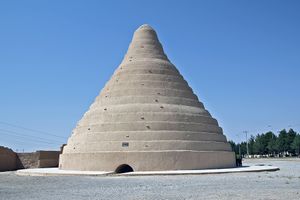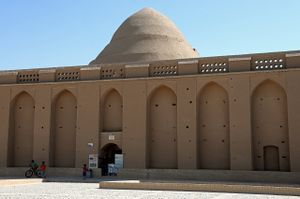야크찰: 두 판 사이의 차이
편집 요약 없음 |
편집 요약 없음 |
||
| 1번째 줄: | 1번째 줄: | ||
[[파일:Ice House Iran.jpg|thumb|아가자데 야크찰]] | [[파일:Ice House Iran.jpg|thumb|아가자데 야크찰]] | ||
'''야크찰'''({{llang|fa|یخچال}}, Yakhchāl = ''Yakh'' ‘얼음’+''chāl'' ‘구덩이’)은 [[페르시아]](현대 [[이란]])지역에서 형성된, [[증발식 냉각기]] 기능을 하는 고대의 [[빙고]] 중 하나이다. | '''야크찰'''({{llang|fa|یخچال}}, Yakhchāl, Yakchal<ref name="bp22" /> = ''Yakh'' ‘얼음’+''chāl'' ‘구덩이’)은 [[페르시아]](현대 [[이란]])지역에서 형성된, [[증발식 냉각기]] 기능을 하는 고대의 [[빙고]] 중 하나이다. | ||
이 건축물은 땅을 파 햇빛을 막을 벽, 물을 얼릴 냉동 구덩이와 저장고 공간을 마련하고 저장고 그 위에 돔이나 아치 형태의 구조물을 쌓아올리는 형태로 되어 있다<ref name="jah21">{{저널 인용|성=Ebrahimi|이름=Ali|성2=Shayegani|이름2=Aida|성3=Zarandi|이름3=Mahnaz Mahmoudi |제목=Thermal Performance of Sustainable Element in Moayedi Icehouse in Iran |저널=International Journal of Architectural Heritage |날짜=2021-05-04 |권=15 |호=5 |쪽=740-756|doi=10.1080/15583058.2019.1645243|언어고리=en}}</ref>. 지하공간에 두꺼운 단열구조체가 덮여 있어 연중 어느때라도 저장고의 열을 막아 준다. 구체적 형태로는 돔형, 지하형, 웅덩이형이 있다<ref name="ach12">{{저널 인용|성=Mahdavinejad|이름=M|이름2=Kavan|성2=Javanrudi |title=Assessment of Ancient Fridges: A Sustainable Method to Storage Ice in Hot-Arid Climates|journal=Asian Culture and History|date=2012-07|volume=4|issue=2|doi=10.5539/ach.v4n2p133 |쪽=133-139 |doi-access=free|언어고리=en}}</ref>. 보통 얼음을 보존하는데 쓰이지만 먹거리를 저장할 때도 쓰인다. 현재도 수백년 된 야크찰이 여러 곳 남아있다<ref name="ach12" />. | 이 건축물은 땅을 파 햇빛을 막을 벽, 물을 얼릴 냉동 구덩이와 저장고 공간을 마련하고 저장고 그 위에 돔이나 아치 형태의 구조물을 쌓아올리는 형태로 되어 있다<ref name="jah21">{{저널 인용|성=Ebrahimi|이름=Ali|성2=Shayegani|이름2=Aida|성3=Zarandi|이름3=Mahnaz Mahmoudi |제목=Thermal Performance of Sustainable Element in Moayedi Icehouse in Iran |저널=International Journal of Architectural Heritage |날짜=2021-05-04 |권=15 |호=5 |쪽=740-756|doi=10.1080/15583058.2019.1645243|언어고리=en}}</ref>. 지하공간에 두꺼운 단열구조체가 덮여 있어 연중 어느때라도 저장고의 열을 막아 준다. 구체적 형태로는 돔형, 지하형, 웅덩이형이 있다<ref name="ach12">{{저널 인용|성=Mahdavinejad|이름=M|이름2=Kavan|성2=Javanrudi |title=Assessment of Ancient Fridges: A Sustainable Method to Storage Ice in Hot-Arid Climates|journal=Asian Culture and History|date=2012-07|volume=4|issue=2|doi=10.5539/ach.v4n2p133 |쪽=133-139 |doi-access=free|언어고리=en}}</ref>. 보통 얼음을 보존하는데 쓰이지만 먹거리를 저장할 때도 쓰인다. 현재도 수백년 된 야크찰이 여러 곳 남아있다<ref name="ach12" />. | ||
| 13번째 줄: | 13번째 줄: | ||
The building allows cold air to pour in from entries at the base of the structure and descend to the lowest part of the yakhchāl, large underground spaces up to 5,000 m3 (180,000 cu ft) in volume. At the same time, the tall conical shape of the building guides any remaining heat upward and outside through openings at the very top of the building, and through this active process the air inside the yakhchāl remains cooler than the outside. The yakhchāl is built of a unique water-resistant mortar called sarooj, composed of sand, clay, egg whites, lime, goat hair, and ash in specific proportions, that is resistant to heat transfer and is thought to be completely water-impenetrable.[2] This material acts as an effective insulation all year round. The sarooj walls are at least two meters thick at the base.[3] --> | The building allows cold air to pour in from entries at the base of the structure and descend to the lowest part of the yakhchāl, large underground spaces up to 5,000 m3 (180,000 cu ft) in volume. At the same time, the tall conical shape of the building guides any remaining heat upward and outside through openings at the very top of the building, and through this active process the air inside the yakhchāl remains cooler than the outside. The yakhchāl is built of a unique water-resistant mortar called sarooj, composed of sand, clay, egg whites, lime, goat hair, and ash in specific proportions, that is resistant to heat transfer and is thought to be completely water-impenetrable.[2] This material acts as an effective insulation all year round. The sarooj walls are at least two meters thick at the base.[3] --> | ||
야크찰은 종종 [[카나트]] 수로와 연결되어 있으며, 동시에 바드기르(바람탑)을 갖춘 경우도 많았다<ref name="bp22">{{cite journal |last1=Ghaderian |first1=Massoud |title=Collaboration Between Nature and Humans in the Desert: The Qanat System in Iran |journal=Blue Papers |date=1 September 2022 |volume=1 |issue=1 |page=138-149 |pages=139–149 |doi=10.58981/bluepapers.2022.1.14}}</ref>. | |||
2023년 3월 28일 (화) 17:43 판

야크찰(페르시아어: یخچال, Yakhchāl, Yakchal[1] = Yakh ‘얼음’+chāl ‘구덩이’)은 페르시아(현대 이란)지역에서 형성된, 증발식 냉각기 기능을 하는 고대의 빙고 중 하나이다.
이 건축물은 땅을 파 햇빛을 막을 벽, 물을 얼릴 냉동 구덩이와 저장고 공간을 마련하고 저장고 그 위에 돔이나 아치 형태의 구조물을 쌓아올리는 형태로 되어 있다[2]. 지하공간에 두꺼운 단열구조체가 덮여 있어 연중 어느때라도 저장고의 열을 막아 준다. 구체적 형태로는 돔형, 지하형, 웅덩이형이 있다[3]. 보통 얼음을 보존하는데 쓰이지만 먹거리를 저장할 때도 쓰인다. 현재도 수백년 된 야크찰이 여러 곳 남아있다[3].
작동방식

기원전 400년 즈음, 페르시아 기술자들이 사막에 얼음을 저장하기 위해 야크찰을 짓기 시작했다.
야크찰은 종종 카나트 수로와 연결되어 있으며, 동시에 바드기르(바람탑)을 갖춘 경우도 많았다[1].
평가
주
- ↑ 1.0 1.1 (1 September 2022) Collaboration Between Nature and Humans in the Desert: The Qanat System in Iran. 《Blue Papers》 1 (1): 138-149. doi:10.58981/bluepapers.2022.1.14.
- ↑ (영어) Ebrahimi, Ali, Shayegani, Aida, Zarandi, Mahnaz Mahmoudi (2021년 5월 4일). Thermal Performance of Sustainable Element in Moayedi Icehouse in Iran. 《International Journal of Architectural Heritage》 15 (5): 740-756. doi:10.1080/15583058.2019.1645243.
- ↑ 3.0 3.1 (영어) Mahdavinejad, M, Javanrudi, Kavan (2012년 7월). Assessment of Ancient Fridges: A Sustainable Method to Storage Ice in Hot-Arid Climates. 《Asian Culture and History》 4 (2): 133-139. doi:10.5539/ach.v4n2p133.

